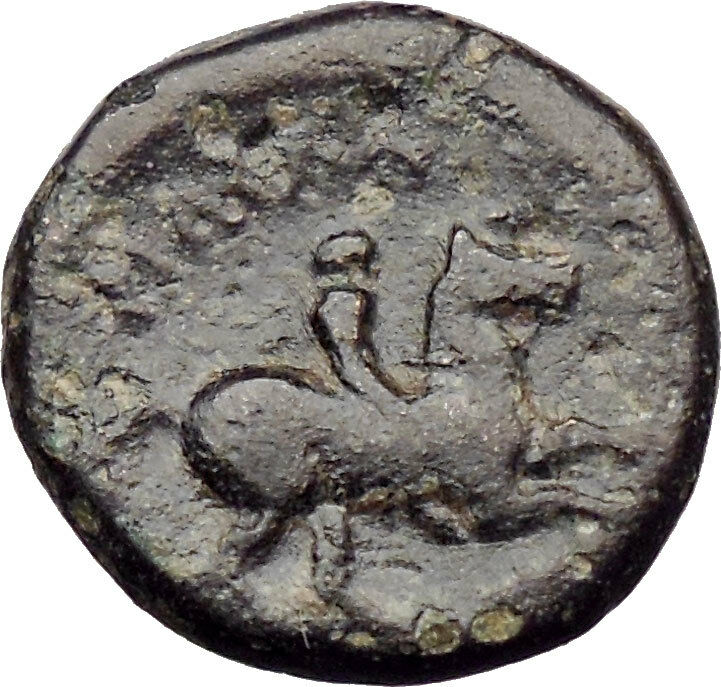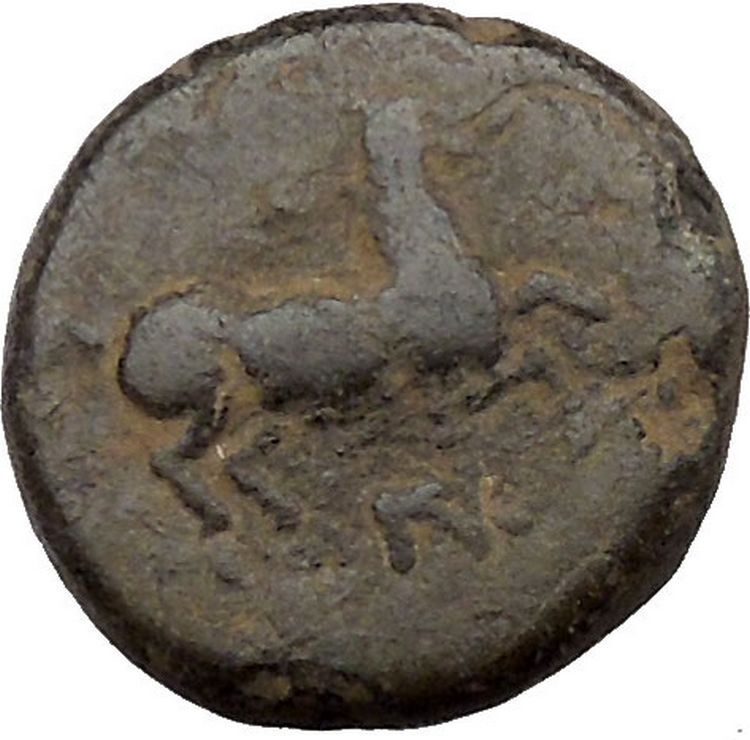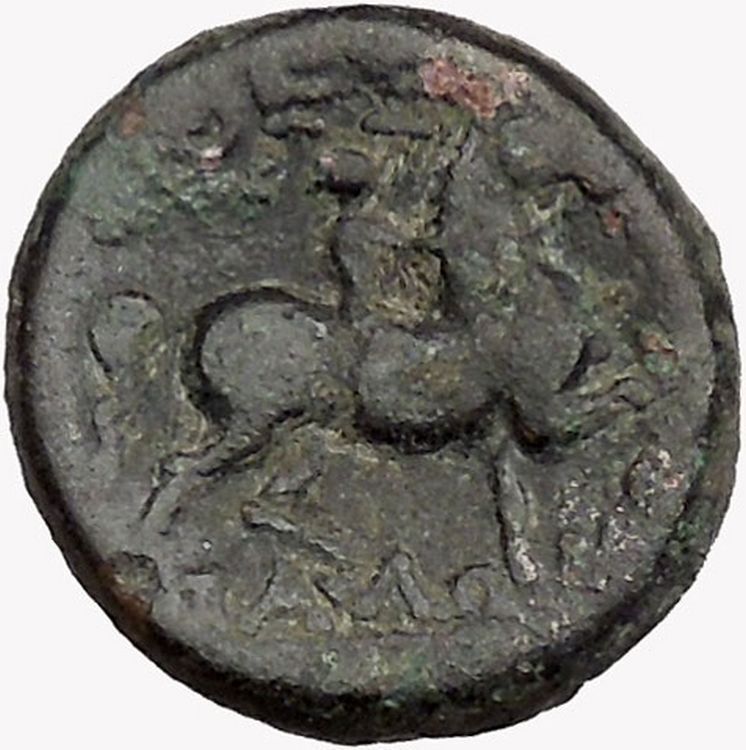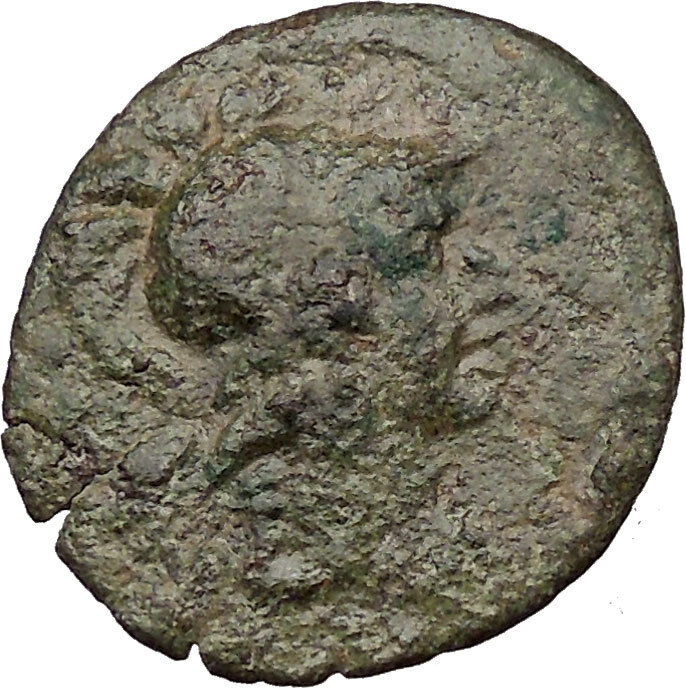|
Greek city of Syracuse in Sicily
Time of Timoleon 344-336 B.C.
Bronze Trias 17mm (5.76 grams)
Reference: Sear 1193; B.M.C. 2. 289
ΣYPA – Head of Athena left, wearing
Corinthian helmet bound with olive-wreath, dolphins,
before and behind.
Hippocamp left, with curled wing.
You are bidding on the exact item pictured,
provided with a Certificate of Authenticity and Lifetime Guarantee of
Authenticity.
The hippocamp or hippocampus (plural: hippocamps or hippocampi;
Greek
: ἱππόκαμπος,
from ἵππος, “horse” and
κάμπος, “monster”), often called a
sea-horse in
English
, is a mythological creature shared by
Phoenician
[3]
and
Greek mythology
, though the name by which it is
recognised is purely Greek; it became part of
Etruscan mythology
. It has typically been
depicted as a horse in its forepart with a coiling, scaly, fishlike
hindquarter
.
Mythology

Hippocamp in Roman mosaic in the
thermae
at
Aquae Sulis
(Bath)
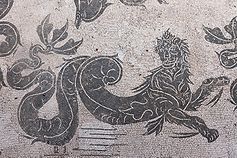
A sea-lion mosaic in the Baths of Neptune,
Ostia Antica
Homer
describes
Poseidon
, who was god of horses (Poseidon
Hippios), earthquakes, and the sea, drawn by “brazen-hoofed”
horses over the sea’s surface, and
Apollonius of Rhodes
, being consciously archaic
in Argonautica
(iv.1353ff), describes the
horse of Poseidon emerging from the sea and galloping away across the
Libyan
sands.[4]
In
Hellenistic
and
Roman
imagery, however, Poseidon (or Roman
Neptune
) often drives a sea-chariot
drawn by hippocampi. Thus hippocamps sport with this god in both ancient
depictions and much more modern ones, such as in the waters of the 18th-century
Trevi Fountain
in Rome surveyed by Neptune from
his
niche
above. (illustration, right)
The appearance of hippocamps in both
freshwater
and
saltwater
is counter-intuitive to a modern
audience, though not to an ancient one. The Greek picture of the natural
hydrological cycle
did not take account of the
condensation of atmospheric water as rain to replenish the
water table
, but imagined the refreshening of
the waters of the sea oozing back landwards through vast underground
caverns
and
aquifers
, rising replenished and freshened in
springs.
Thus it was natural for a temple at
Helike
in the coastal plain of
Achaea
to be dedicated to Poseidon
Helikonios, (the Poseidon of Helicon), the sacred spring of
Boeotian Helikon
.[6]
When an earthquake suddenly submerged the city, the temple’s bronze Poseidon
accompanied by hippocamps continued to snag fishermens’ nets.[7]
Likewise, the hippocamp was considered an appropriate decoration for
mosaics
in Roman
thermae
or public baths, as at
Aquae Sulis
modern day
Bath
in Britannia (illustration, below).
Poseidon’s horses, which were included in the elaborate sculptural program of
gilt-bronze and ivory
, added by a Roman client to the temple of
Poseidon at Corinth
, are likely to have been hippocamps;
the Romanised Greek
Pausanias
described the rich ensemble in the
later 2nd century CE (Geography of Greece ii.1.7-.8):
Within the sanctuary of the god stand on the one side portrait statues of
athletes
who have won victories at the
Isthmian games
, on the other side pine
trees growing in a row, the greater number of them rising up straight. On
the temple, which is not very large, stand bronze
Tritons
. In the fore-temple are images, two
of Poseidon, a third of
Amphitrite
, and a Sea, which also is of
bronze. The offerings inside were dedicated in our time by
Herodes Atticus
, four horses, gilded except
for the hoofs, which are of ivory, and two gold
Tritons
beside the horses, with the parts
below the waist of ivory. On the car stand Amphitrite and Poseidon, and
there is the boy
Palaemon
upright upon a
dolphin
. These too are made of ivory and
gold. On the middle of the base on which the car is has been wrought a Sea
holding up the young
Aphrodite
, and on either side are the
nymphs called
Nereids
.

Hippocamp
Art Deco
fountain,
Kansas City, Missouri
,
(1937)
|
Hippocamps appear with the first Orientalising phase of
Etruscan civilization
: they remain a theme in
Etruscan tomb wall-paintings and reliefs, where they are sometimes provided with
wings, as they are in the Trevi fountain. Katharine Shepard found in the theme
an Etruscan belief in a sea-voyage to the other world.[8]
Aside from aigikampoi, the fish-tailed
goats representing
Capricorn
or
Aegeus
(“goat-man”)[9]
other fish-tailed animals rarely appearing in Greek art but more characteristic
of the Etruscans included leokampoi (fish-tailed
lions), taurokampoi (fish-tailed
bulls) or pardalokampoi (fish-tailed
leopards
).[10]
The mythic hippocamp has been used as a
heraldic charge
, particularly since the
Renaissance, most often in the
armorial bearings
of people and places with
maritime associations. However, in a
blazon
, the terms hippocamp and
hippocampus now refer to the real animal called a seahorse, and the
terms seahorse and sea-horse refer to the mythological creature.
The above-mentioned fish hybrids are seen less frequently
Athena
or Athene
(Latin:
Minerva
), also referred to as
Pallas Athena, is the goddess of war, civilization, wisdom, strength,
strategy, crafts, justice and skill in
Greek mythology
.
Minerva
,
Athena’s Roman
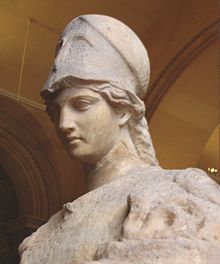
incarnation,
embodies similar attributes. Athena is also a shrewd companion of
heroes and the
goddess
of
heroic endeavour. She is the
virgin
patron of
Athens
. The Athenians built the
Parthenon
on the Acropolis of her namesake
city, Athens, in her honour (Athena Parthenos). Athena’s cult as the patron of
Athens seems to have existed from the earliest times and was so persistent that
archaic myths about her were recast to adapt to cultural changes. In her role as
a protector of the city (polis),
many people throughout the Greek world worshiped Athena as Athena Polias
(“Athena of the city”).
Athens
and Athena bear etymologically connected
names.
Timoleon (Greek:
ΤιμολÎων), son of Timodemus, of
Corinth
(ca.
411–337 BC) was a Greek statesman and general.
As the champion of
Greece
against
Carthage
he
is closely connected with the history of
Sicily
,
especially
Syracuse
.
//
Early
life
When his brother
Timophanes
,
whose life he had saved in battle, took possession of the acropolis of Corinth
and made himself master of the city, Timoleon, after an ineffectual protest,
tacitly acquiesced while the friends who accompanied him put Timophanes to
death. Public opinion approved his conduct as patriotic; but the curses of his
mother and the indignation of some of his kinsfolk drove him into retirement for
twenty years.
Sicily

Sicily 431 BC
Because of the political problems of Syracuse and the threat from Sparta, a
group of Syracusans sent an appeal for help to Corinth which reached Corinth in
344 BC
Corinth
could not refuse help, though her chief citizens declined the responsibility of
attempting to establish a settled government in factious and turbulent Syracuse.
Timoleon, being named by an unknown voice in the popular assembly, was chosen
by a unanimous vote to undertake the mission, and set sail for Sicily with a few
of the leading citizens of Corinth and a small troop of Greek mercenaries. He
eluded a Carthaginian squadron and landed at
Tauromenium
(now Taormina), where he met with a friendly reception. At this
time
Hicetas
, tyrant of
Leontini
, was master of Syracuse, with the exception of the island of
Ortygia
,
which was occupied by
Dionysius
, still nominally tyrant.
Hicetas was defeated at Adranum, an inland town, and driven back to Syracuse.
In 343 Dionysius surrendered Ortygia on condition of being granted a safe
conduct to Corinth. Hicetas now received help from Carthage (60,000 men), but
ill-success roused mutual suspicion; the Carthaginians abandoned Hicetas, who
was besieged in Leontini, and who was then compelled to surrender. Timoleon was
thus master of Syracuse.
He at once began the work of restoration, bringing new settlers from the
mother-city and from Greece generally, and establishing a popular government on
the basis of the democratic laws of
Diocles
. The
citadel was razed to the ground, and a court of justice erected on its site. The
amphi-polos, or priest of Olympian
Zeus, who was
annually chosen by lot out of three clans, was invested with the chief
magistracy. The impress of Timoleon’s reforms seems to have lasted to the days
of Augustus
.
Hicetas again induced Carthage to send (340–339) a great army (70,000), which
landed at Lilybaeum (now Marsala). With a miscellaneous levy of about 12,000
men, most of them mercenaries, Timoleon marched westwards across the island into
the neighbourhood of
Selinus
and won a great and decisive
victory on the Crimissus
. The general himself led his infantry, and the
enemy’s discomfiture was completed by a blinding storm of rain and hail. This
victory gave the Greeks of Sicily many years of peace and safety from Carthage.
Carthage made, however, one more effort and despatched some mercenaries to
prolong the conflict between Timoleon and the tyrants. But it ended in the
defeat of Hicetas, who was taken prisoner and put to death. Carthage then agreed
to a treaty in 338
BC
by which, in Sicily, Carthage was confined to the west of the Halycus (Platani)
and undertook to give no further help to tyrants.
Retirement
Timoleon then retired into private life without assuming any title or office,
though he remained practically supreme, not only at Syracuse, but throughout the
island. Notwithstanding the many elements of discord Sicily seems to have been
during Timoleon’s lifetime tranquil and contented. He became blind some time
before his death, but when important issues were under discussion he was carried
to the assembly to give his opinion, which was usually accepted. He was buried
at the cost of the citizens of Syracuse, who erected a monument to his memory in
their market-place, afterwards surrounded with porticoes, and a gymnasium called
Timoleonteum.
Tyrant
or Democrat?
The ancient historian
Timaeus
gave Timoleon an excellent write up; however, Polybios laid into
Timaeus for bias in favor of Timoleon and many modern historians have sided with
Polybios. Peter Green shares this skepticism but thinks it has gone too far.
While he concedes that Timoleon tended to play the democrat while using the
methods of a tyrant (albeit benevolent), he did make an effort to maintain the
outward forms of democracy. Further, he reformed Syracuse in a democratic
direction and demolished the stronghold of the island that had been so useful to
tyrants in the past.
Syracuse pronounced,
Sicilian
: Sarausa,
Ancient Greek
: Συ�άκουσαι –
transliterated: Syrakousai) is a historic
city in
southern Italy
, the
capital
of the
province of Syracuse
. The city is famous for its rich Greek history,
culture
,
amphitheatres
,
architecture
and association to
Archimedes
,
playing an important role in ancient times as one of the top powers of the
Mediterranean
world; it is over 2,700 years old. Syracuse is located in the
south-east corner of the island of
Sicily
, right
by the Gulf of Syracuse next to the
Ionian Sea
.
The city was founded by
Ancient Greek
Corinthians
and became a very powerful
city-state
.
Syracuse was allied with
Sparta
and
Corinth
,
exerting influence over the entire
Magna Grecia
area of which it was the most important city. Once
described by Cicero
as “the greatest Greek city and the most beautiful of them all”, it later became
part of the
Roman Republic
and
Byzantine Empire
. After this
Palermo
overtook it in importance, as the capital of the
Kingdom of Sicily
. Eventually the kingdom would be united with the
Kingdom of Naples
to form the
Two Sicilies
until the
Italian unification
of 1860.
In the modern day, the city is listed by
UNESCO
as a
World Heritage Site
along with the
Necropolis of Pantalica
. In the central area, the city itself has a
population of around 125,000 people. The inhabitants are known as Siracusans,
and the local language spoken by its inhabitants is the
Sicilian language
. Syracuse is mentioned in the
Bible
in the
Acts of the Apostles
book at 28:12 as
Paul
stayed there.[2]
The patron saint
of the city is
Saint Lucy
;
she was born in Syracuse and her feast day,
Saint Lucy’s Day
, is celebrated on 13 December.
Greek period
Syracuse and its surrounding area have been inhabited since ancient times, as
shown by the findings in the villages of Stentinello, Ognina, Plemmirio,
Matrensa, Cozzo Pantano and Thapsos, which already had a relationship
with
Mycenaean Greece
.
Syracuse was founded in 734 or 733 BC by Greek settlers from
Corinth
and Tenea
,
led by the oecist (colonizer)
Archias
, who called it Sirako, referring to a nearby salt marsh. The
nucleus of the ancient city was the small island of Ortygia. The settlers
found the land fertile and the native tribes to be reasonably well-disposed to
their presence. The city grew and prospered, and for some time stood as the most
powerful Greek city anywhere in the
Mediterranean
. Colonies were founded at
Akrai
(664 BC),
Kasmenai
(643 BC),
Akrillai
(VII century BC), Helorus
(VII century BC) and
Kamarina
(598 BC). The descendants of the first colonist, called Gamoroi, held the
power until they were expelled by the Killichiroi, the lower class of the
city. The former, however, returned to power in 485 BC, thanks to the help of
Gelo, ruler of
Gela. Gelo himself
became the despot of the city, and moved many inhabitants of Gela, Kamarina and
Megera to Syracuse, building the new quarters of
Tyche
and
Neapolis
outside the walls. His program of new constructions included a new
theater, designed by
Damocopos
, which gave the city a flourishing cultural life: this in turn
attracted personalities as
Aeschylus
,
Ario of
Metimma
, Eumelos of
Corinth
and
Sappho
, who had
been exiled here from
Mytilene
.
The enlarged power of Syracuse made unavoidable the clash against the
Carthaginians
, who ruled western Sicily. In the
Battle of Himera
, Gelo, who had allied with Theron of
Agrigento
,
decisively defeated the African force led by
Hamilcar
. A
temple
,
entitled to Athena
(on the site of the today’s Cathedral), was erected in the city to commemorate
the event
Gelon was succedeed by his brother
Hiero
, who
fought
against the
Etruscans
at Cumae
in 474 BC. His rule was eulogized by poets like
Simonides of Ceos
,
Bacchylides
and Pindar
, who visited his court. A democratic regime was introduced by
Thrasybulos
(467 BC). The city continued to expand in
Sicily
,
fighting against the rebellious
Siculi
, and on the
Tyrrhenian Sea
, making expeditions up to
Corsica
and
Elba. In the late
5th century BC, Syracuse found itself at war with
Athens
, which
sought more resources to fight the
Peloponnesian War
. The Syracusans enlisted the aid of a general from
Sparta
, Athens’
foe in the war, to defeat the Athenians, destroy their ships, and leave them to
starve on the island (see
Sicilian Expedition
). In 401 BC, Syracuse contributed a force of 3,000
hoplites
and a general to
Cyrus the Younger
‘s
Army of the Ten Thousand
.
Then in the early 4th century BC, the
tyrant
Dionysius the Elder
was again at war against
Carthage
and, although losing Gela and Camarina, kept that power from capturing the whole
of Sicily. After the end of the conflict Dionysius built a massive fortress on
the Ortygia
island of the city and 22 km-long walls around all of Syracuse. Another period
of expansion saw the destruction of
Naxos
, Catania
and Lentini
, then Syracuse entered again in war against Carthage (397 BC). After
various changes of fortune, the Carthaginians managed to besiege Syracuse
itself, but were eventually pushed back by a pestilence. A treaty in 392 BC
allowed Syracuse to enlarge further its possessions, founding the cities of
Adrano, Ancona
,
Adria
, Tindari
and Tauromenos, and conquering
Reggio Calabria
on the continent. Apart from his battle deeds, Dionysius was
famous as a patron of art, and
Plato
himself
visited Syracuse several times.
His successor was
Dionysius the Younger
, who was however expelled by
Dion
in 356 BC. But the latter’s despotic rule led in turn to his expulsion,
and Dionysius reclaimed his throne in 347 BC. A democratic government was
installed by Timoleon
in 345 BC. The long series of internal struggles had weakened
Syracuse’s power on the island, and Timoleon tried to remedy this, defeating the
Carthaginians in 339 BC near the
Krimisos
river. But the struggle among the city’s parties restarted after
his death and ended with the rise of another tyrant,
Agathocles
,
who seized power with a coup in 317 BC. He resumed the war against Carthage,
with alternate fortunes. He however scored a moral success, bringing the war to
the Carthaginians’ native African soil, inflicting heavy losses to the enemy.
The war ended with another treaty of peace which did not prevent the
Carthaginians interfering in the politics of Syracuse after the death of
Agathocles (289 BC). The citizens called
Pyrrhus of Epirus
for help. After a brief period under the rule of Epirus,
Hiero II
seized power in 275 BC.
Hiero inaugurated a period of 50 years of peace and prosperity, in which
Syracause became one of the most renowned capitals of Antiquity. He issued the
so-called Lex Hieronica, which was later adopted by the Romans for their
administration of Sicily; he also had the theater enlarged and a new immense
altar
, the “Hiero’s
Ara”, built. Under his rule lived the most famous Syracusan, the
natural philosopher
Archimedes
.
Among his many inventions were various military engines including the
claw of Archimedes
, later used to resist the
Roman
siege of 214 BC–212 BC. Literary figures included
Theocritus
and others.
Hiero’s successor, the young
Hieronymus
(ruled from 215 BC), broke the alliance with the Romans after
their defeat at the
Battle of Cannae
and accepted
Carthage
‘s
support. The Romans, led by consul
Marcus Claudius Marcellus
,
besieged the city
in 214 BC. The city held out for three years, but fell in
212 BC. It is believed to have fallen due to a peace party opening a small door
in the wall to negotiate a peace, but the Romans charged through the door and
took the city, killing Archimedes in the process.
From
Roman domination to the Middle Ages
Though declining slowly by the years, Syracuse maintained the status of
capital of the Roman government of Sicily and seat of the
praetor
. It
remained an important port for the trades between the Eastern and the Western
parts of the Empire.
Christianity
spread in the city through the efforts of
Paul of Tarsus
and Saint Marziano, the first bishop of the city, who made it
one of the main centres of
proselytism
in the West. In the age of the persecutions massive
catacombs
were carved, whose size is second only to those of Rome.
After a period of
Vandal
rule, Syracuse and the island was recovered by
Belisarius
for the
Byzantine Empire
(31 December 535). From 663 to 668 Syracuse was the seat of
Emperor Constans II
, as well as metropolis of the whole Sicilian Church.
Another siege in 878, resulted in the city coming under two centuries of
Muslim
rule. The
capital was moved from Syracuse to
Palermo
. The
Cathedral was converted into a
mosque
and the
quarter on the Ortygia island was gradually rebuilt along Islamic styles. The
city, nevertheless, maintained important trade relationships, and housed a
relatively flourishing cultural and artistic life: several Arab poets, including
Ibn Hamdis
,
the most important Sicilian poet of the 12th century, flourished in the city.
In 1038, the Byzantine general
George Maniaces
reconquered the city, sending the relics of St. Lucy to
Constantinople
. The eponymous castle on the cape of Ortygia bears his name,
although it was built under the
Hohenstaufen
rule. In 1085 the
Normans
entered Syracuse, one of the last
Arab
strongholds, after a summer-long siege by
Roger I of Sicily
and his son
Jordan of Hauteville
, who was given the city as count. New quarters were
built, and the cathedral was restored, as well as other churches.
In 1194
Henry VI
of Swabia
occupied Syracuse. After a short period of
Genoese
rule (1205–1220), which favoured a rise of trades, Syracuse was
conquered back by emperor
Frederick II
. He began the construction of the
Castello Maniace
, the Bishops’ Palace and the Bellomo Palace. Frederick’s
death brought a period of unrest and feudal anarchy. In the struggle between the
Anjou
and
Aragonese
monarchies, Syracuse sided with the Aragonese and defeated the
Anjou in 1298, receiving from the Spanish sovereigns great privileges in reward.
The pre-eminence of baronal families is also shown by the construction of the
palaces of Abela
,
Chiaramonte
, Nava
,
Montalto
.
|











